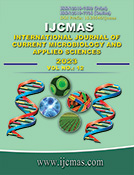


 National Academy of Agricultural Sciences (NAAS)
National Academy of Agricultural Sciences (NAAS)

|
PRINT ISSN : 2319-7692
Online ISSN : 2319-7706 Issues : 12 per year Publisher : Excellent Publishers Email : editorijcmas@gmail.com / submit@ijcmas.com Editor-in-chief: Dr.M.Prakash Index Copernicus ICV 2018: 95.39 NAAS RATING 2020: 5.38 |
The research work was carried out to analyse the breeding practices followed by the goat farmers in southern districts of Tamil Nadu. Majority of the goat farmers used own farm bred male animals (38.88 per cent) for breeding purpose followed by purchased the bucks from other goat farmer’s herd (25.66 per cent). They maintained the sex ratio of male to female goats as 1:20 (37.22 per cent), 1: 25-30 (42.78 per cent), 1: 1 above 30 (20 per cent) in the study area. Chi-square revealed that there was a highly significant (P< 0.01) association was observed between sex ratio of goats in the farmers herds among districts. The age at first mating in Kanniadu, Kodi adu and non-descript breeds of goats were 10.00 ± 0.23, 10.07 ± 0.16 and 10.18 ± 0.09 months, respectively and kidding interval for the above three breeds were 7.50 ± 0.16, 7.35 ± 0.16 and 7.44 ± 0.06 months, respectively. The kidding and twinning per cent was significantly (P< 0.05) higher in non-descript goats. Triplets and quadruplets were significantly (P< 0.01) higher in Kanniadu. Lifetime use for breeding purpose was significantly higher for Kodi adu goats.Production and supply of superior male germplasm from the research institutes and organized livestock farms is helpful to maintain the breed characteristics of native goats.
 |
 |
 |
 |
 |